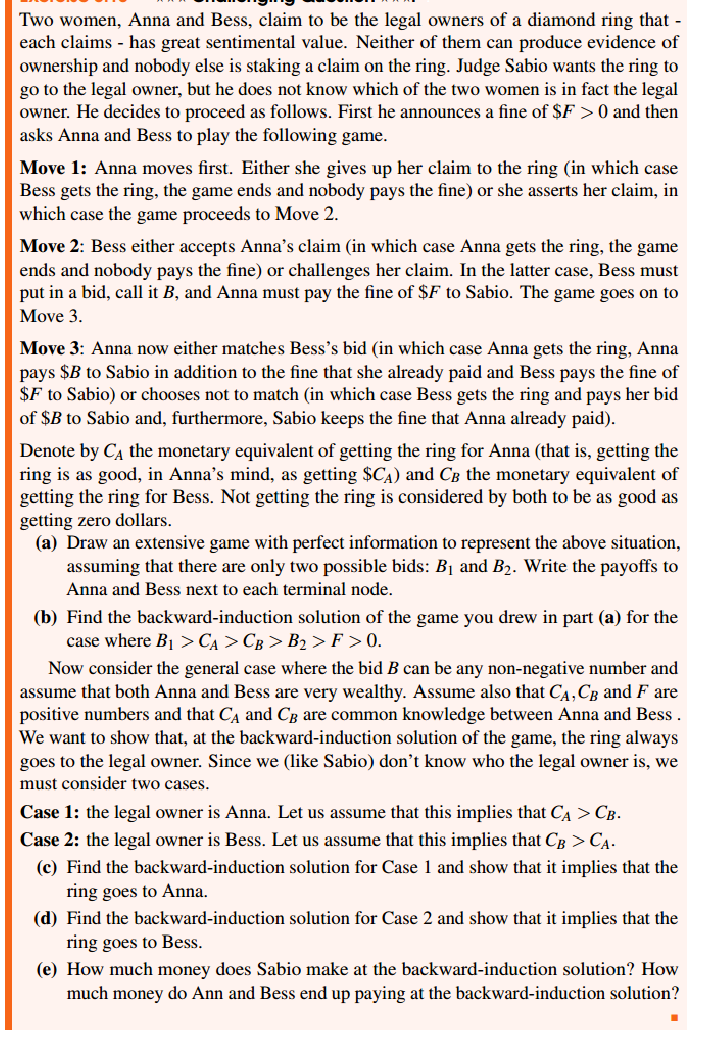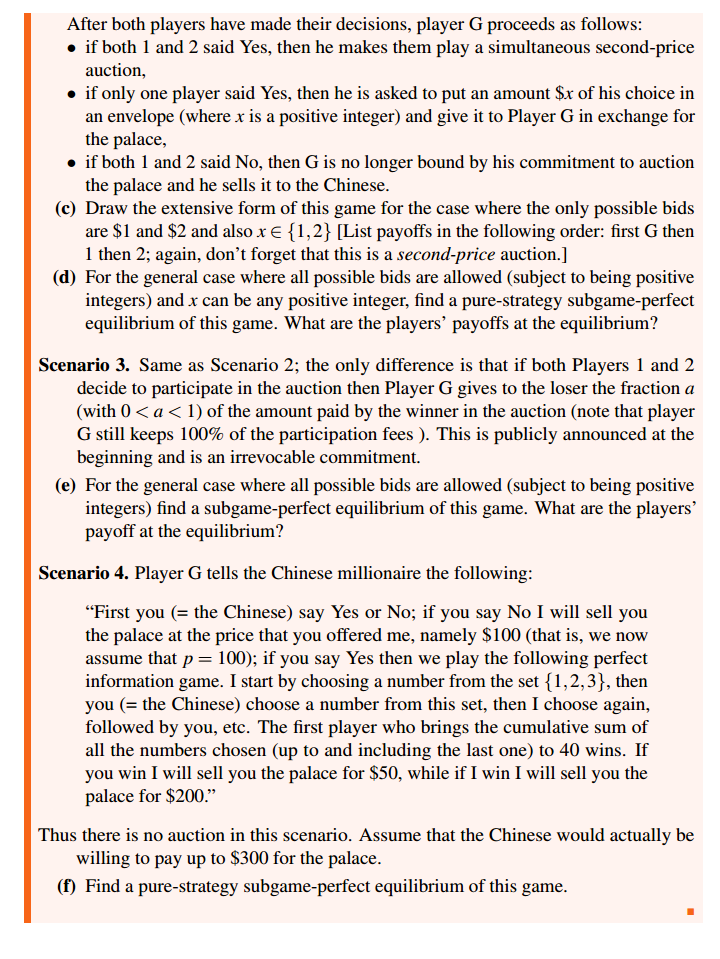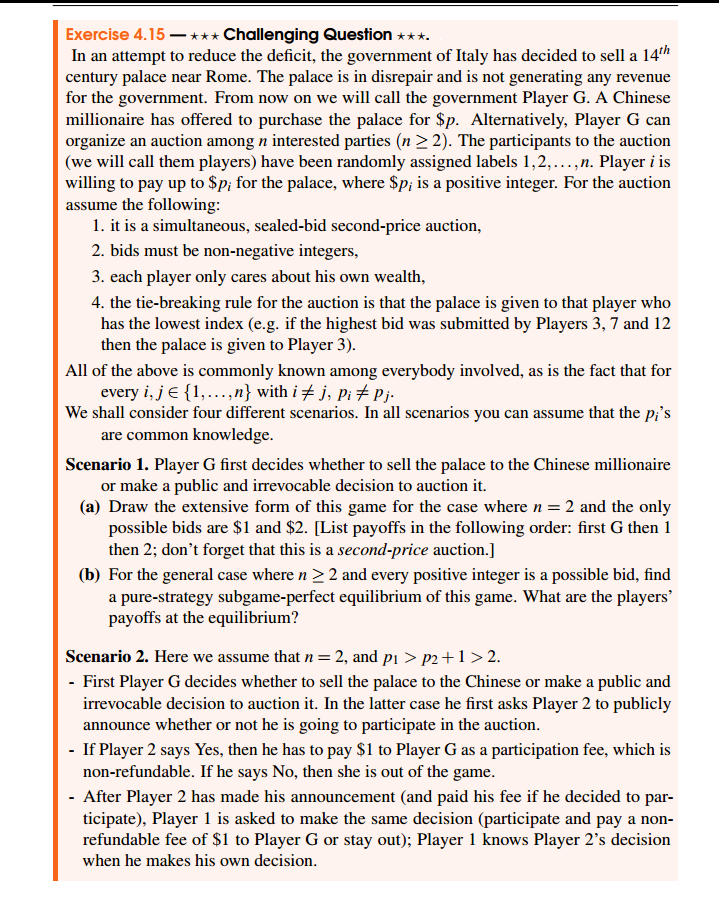


Game theory questions answer all
Two women, Anna and Bess, claim to be the legal owners of a diamond ring that - each claims - has great sentimental value. Neither of them can produce evidence of ownership and nobody else is staking a claim on the ring. Judge Sabio wants the ring to go to the legal owner, but he does not know which of the two women is in fact the legal owner. He decides to proceed as follows. First he announces a fine of SF > 0 and then asks Anna and Bess to play the following game. Move 1: Anna moves first. Either she gives up her claim to the ring (in which case Bess gets the ring, the game ends and nobody pays the fine) or she asserts her claim, in which case the game proceeds to Move 2. Move 2: Bess either accepts Anna's claim (in which case Anna gets the ring, the game ends and nobody pays the fine) or challenges her claim. In the latter case, Bess must put in a bid, call it B, and Anna must pay the fine of $F to Sabio. The game goes on to Move 3. Move 3: Anna now either matches Bess's bid (in which case Anna gets the ring, Anna pays $B to Sabio in addition to the fine that she already paid and Bess pays the fine of $F to Sabio) or chooses not to match (in which case Bess gets the ring and pays her bid of $B to Sabio and, furthermore, Sabio keeps the fine that Anna already paid). Denote by CA the monetary equivalent of getting the ring for Anna (that is, getting the ring is as good, in Anna's mind, as getting $CA) and CB the monetary equivalent of getting the ring for Bess. Not getting the ring is considered by both to be as good as getting zero dollars. (a) Draw an extensive game with perfect information to represent the above situation, assuming that there are only two possible bids: Bj and B2. Write the payoffs to Anna and Bess next to each terminal node. (b) Find the backward-induction solution of the game you drew in part (a) for the case where B1 > CA > CB > B2 > F > 0. Now consider the general case where the bid B can be any non-negative number and assume that both Anna and Bess are very wealthy. Assume also that CA, CB and F are positive numbers and that CA and Cp are common knowledge between Anna and Bess . We want to show that, at the backward-induction solution of the game, the ring always goes to the legal owner. Since we (like Sabio) don't know who the legal owner is, we must consider two cases. Case 1: the legal owner is Anna. Let us assume that this implies that CA > CB. Case 2: the legal owner is Bess. Let us assume that this implies that CB > CA. (c) Find the backward-induction solution for Case 1 and show that it implies that the ring goes to Anna. (d) Find the backward-induction solution for Case 2 and show that it implies that the ring goes to Bess. (e) How much money does Sabio make at the backward-induction solution? How much money do Ann and Bess end up paying at the backward-induction solution?After both players have made their decisions, player G proceeds as follows: a if both 1 and 2 said Yes, then he makes them play a simultaneous second-price auction, a if only one player said Yes, then he is asked to put an amount $3: of his choice in an envelope (where x is a positive integer) and give it to Player G in exchange for the palace, e if both 1 and 2 said No, then G is no longer bound by his commitment to auction the palace and he sells it to the Chinese. {1:} Draw the extensive form of this game for the case where the only possible bids are $1 and $2 and also I E {1,2} [List payoffs in the following order: rst G then 1 then 2; again, don't forget that this is a second-price auction] (d) For the general case where all possible bids are allowed {subject to being positive integers} and .r can be any positive integer, nd a pure-strategy subgame-perfect equilibrium of this game. What are the players' payoffs at the equilibrium?r Scenario 3. Same as Scenario 2; the only difference is that if both Players 1 and 2 decide to participate in the auction then Player G gives to the loser the fraction :1 (with {1 2). The participants to the auction (we will call them players) have been randomly assigned labels 1,2, ..., n. Player i is willing to pay up to $p; for the palace, where $p; is a positive integer. For the auction assume the following: 1. it is a simultaneous, sealed-bid second-price auction, 2. bids must be non-negative integers, 3. each player only cares about his own wealth, 4. the tie-breaking rule for the auction is that the palace is given to that player who has the lowest index (e.g. if the highest bid was submitted by Players 3, 7 and 12 then the palace is given to Player 3). All of the above is commonly known among everybody involved, as is the fact that for every i, je {1,...,n} with i / j, pi # Pj. We shall consider four different scenarios. In all scenarios you can assume that the pi's are common knowledge. Scenario 1. Player G first decides whether to sell the palace to the Chinese millionaire or make a public and irrevocable decision to auction it. (a) Draw the extensive form of this game for the case where n = 2 and the only possible bids are $1 and $2. [List payoffs in the following order: first G then 1 then 2; don't forget that this is a second-price auction.] (b) For the general case where n 2 2 and every positive integer is a possible bid, find a pure-strategy subgame-perfect equilibrium of this game. What are the players' payoffs at the equilibrium? Scenario 2. Here we assume that n = 2, and p1 > p2 + 1 > 2. - First Player G decides whether to sell the palace to the Chinese or make a public and irrevocable decision to auction it. In the latter case he first asks Player 2 to publicly announce whether or not he is going to participate in the auction. If Player 2 says Yes, then he has to pay $1 to Player G as a participation fee, which is non-refundable. If he says No, then she is out of the game. After Player 2 has made his announcement (and paid his fee if he decided to par- ticipate), Player 1 is asked to make the same decision (participate and pay a non- refundable fee of $1 to Player G or stay out); Player 1 knows Player 2's decision when he makes his own decision












